Manchester City Women are gunning for the FAWSL title in what is proving to be one of the most absorbing title races in recent seasons. Chelsea Women and Arsenal Women are proving to be worthy contenders with the Blues, flexing their credentials with their dominant standout victory against the Gunners. City, on the other hand, are slowly but surely improving their performances and are peaking at the right time. Nick Cushing can be credited to their rich vein of form due to the tactical alterations he’s made over the season to get the Citizens performing. Janine Beckie’s move to right-back proved to be the catalyst having altered their playing style. These changes have affected midfield and seen a slight reshuffle there and at the heart of the engine is the dynamic playmaker Caroline Weir.
In this scout report, we will detail Weir’s contributions in both an attacking and defensive capacity and how she fits into Cushing’s tactics. Through tactical analysis, we will also compare Weir’s statistics with other top central midfielders to determine what the numbers say about her performance.
Caroline Weir – What is her role?
Weir plays as a central midfielder in a double pivot for Manchester City Women. She can be classified as a deep-lying playmaker anchoring midfield alongside Keira Walsh transitioning possession from defence and attack, acting as a link for the more attacking players. Weir has natural ball-playing ability and has an excellent eye for a pass. Equally the Citizens playmaker is a proficient dribbler applying pressure on opposing defences when the need arises. Her ability to switch from playmaker to dribbler is what makes her such an integral part of City’s game.
This description sums up her style of play this season under Cushing. His tactics have been part of the reason for her improved performances but the Scottish midfielder has adjusted to any systems she has played under. A dynamic presence in midfield, Weir loves keeping possession and smartly distributes it towards more advanced players. Her partnership with Walsh has blossomed into a pairing that rivals any top club. The two players complement each other and are able to interchange positions almost seamlessly.
Manchester City Women’s system
To better understand Weir’s strengths, we will use analysis to elaborate and explain City’s style of play this season and how it’s been so successful. The early part of the season saw Cushing employ a mirror to Pep Guardiola’s 4-3-3 system. The right-back Aiofe Mannion would play a more defensive role and tuck in slightly with Demi Stokes bombing forward on the left side. Making up the midfield trio would be Walsh, Weir, and Jill Scott. Walsh would play a sole holding midfield role flanked by Scott and Weir, who would play a more aggressive and attacking role.
One of the issues with the old system was City’s wide players, specifically on the right side would often be left isolated. While Weir could make late runs into the channels, she found it difficult to find an extra runner because Wullaert would be marked by the opposition and Mannion would often be deeper in a more defensive position.
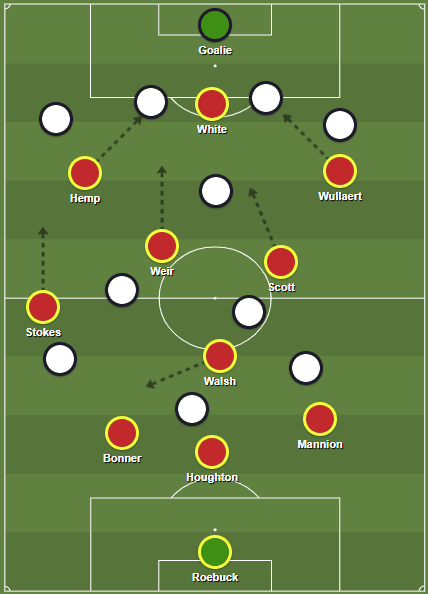
The injury to Mannion forced Cushing into rethinking his strategy and made a bold decision to go with Beckie – a natural forward – at right-back. This move proved to be a masterstroke as this slight tactical adjustment changed the way City were able to attack. Taking advantage of her attacking nature, Beckie has been seen making marauding runs down the right flank more than when she was deployed as a striker and right-winger. Her performances have been largely impressive and as a result, the team as well.
Another by-product of this move has been the move to a double-pivot with Weir moving next to Walsh. But, Weir still retains some freedom to burst forward. When City are attacking, Weir is able to make judgment calls as to when to gamble a run into the final third. Beckie’s marauding runs has also given Weir another opportunity to create numerical superiority and overloads in the wide areas opening up pockets of space. Weir’s exquisite passing and intelligent movement combined with this newfound space has seen City penetrate through opposition defences. The 5-1 win over West Ham Women and 5-0 victory over Bristol City is a testament to this change.
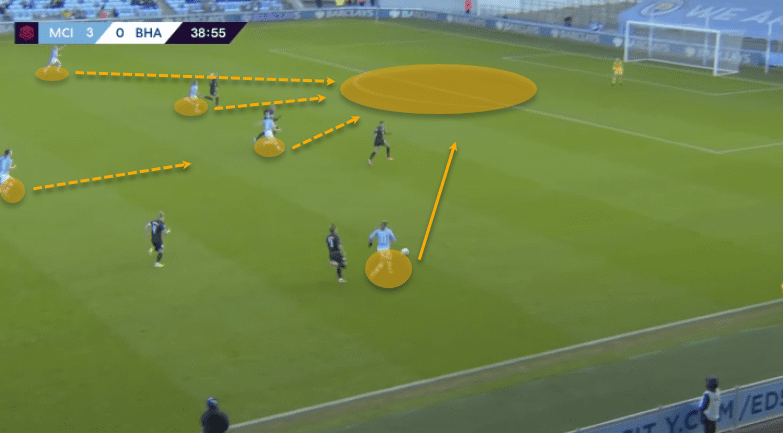
You can see Beckie attacking down the right flank with two Liverpool players chasing her. Not only has this opened the space in the wide area but put City’s strikers in a position to isolate themselves in 1v1 situations and allow the deeper midfielders (Weir & Scott) to make late runs into the box creating an overload.
A statistical analysis of Caroline Weir
In an era where data analysis and statistical models are more prevalent than ever, it makes sense for us to analyse Weir and what her major attributes say about her. After understanding her role in Cushing’s tactical setup, it becomes much easier to understand her role within the system.
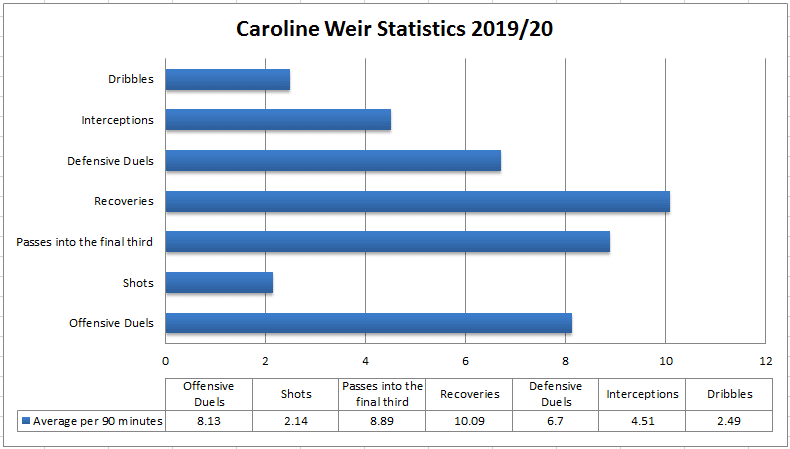
Looking at the above metrics, we can see from an attacking point of view, her passes into the final third, shots, and dribbles per 90 all indicate that she isn’t afraid to take long shots. Cushing wants his players transitioning through the wide areas and creating overloads so Weir’s offensive contribution is a welcome bonus when they move centrally and need to breakdown stubborn defences. While her shots and dribbles per 90 aren’t as high as an attacking midfielder or winger, it is enough for a player like her to contribute and make a difference on the ball. Her goal against Manchester United in the opening game of the season proved as much.
Now, if we look at Weir’s contributions from a defensive standpoint, we can see her standout qualities include her defensive duels, recoveries, and interceptions. All three of these data metrics indicate that Weir has an influence defensively since Cushing’s change in tactics. Positioning her next to Walsh in the double-pivot has increased her defensive responsibilities making City much more resolute. It’s important to note that from her 10.09 recoveries per 90, 62.9% of them come in the opposition half coupled with 4.51 interceptions making her an excellent ball-winner high up the pitch in line with the team’s high pressing system.
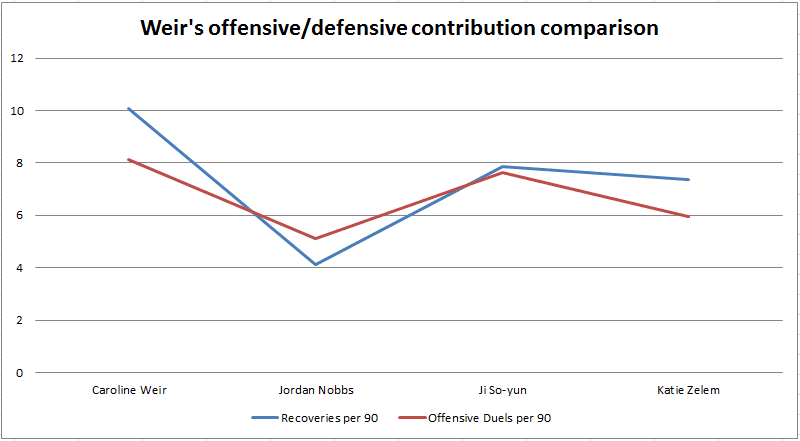
I wanted to look at data and compare Weir to three other central midfielders and see how she compares against them in terms of recoveries per 90 and offensive duels. The purpose of this is to show how well is able to control midfield through aggressive pressing and ability to initiate counter-attacks. Chelsea, City, Arsenal, Manchester United all press teams high up the pitch in some capacity. The responsibility lies between the forward players and central midfielders, so comparing Weir to Katie Zelem, Ji So-yun, and Jordan Nobbs should suffice. From this data we can see she is quite adept in both departments against her counterparts. Her offensive and defensive contribution from these two metrics alone shows her superiority.
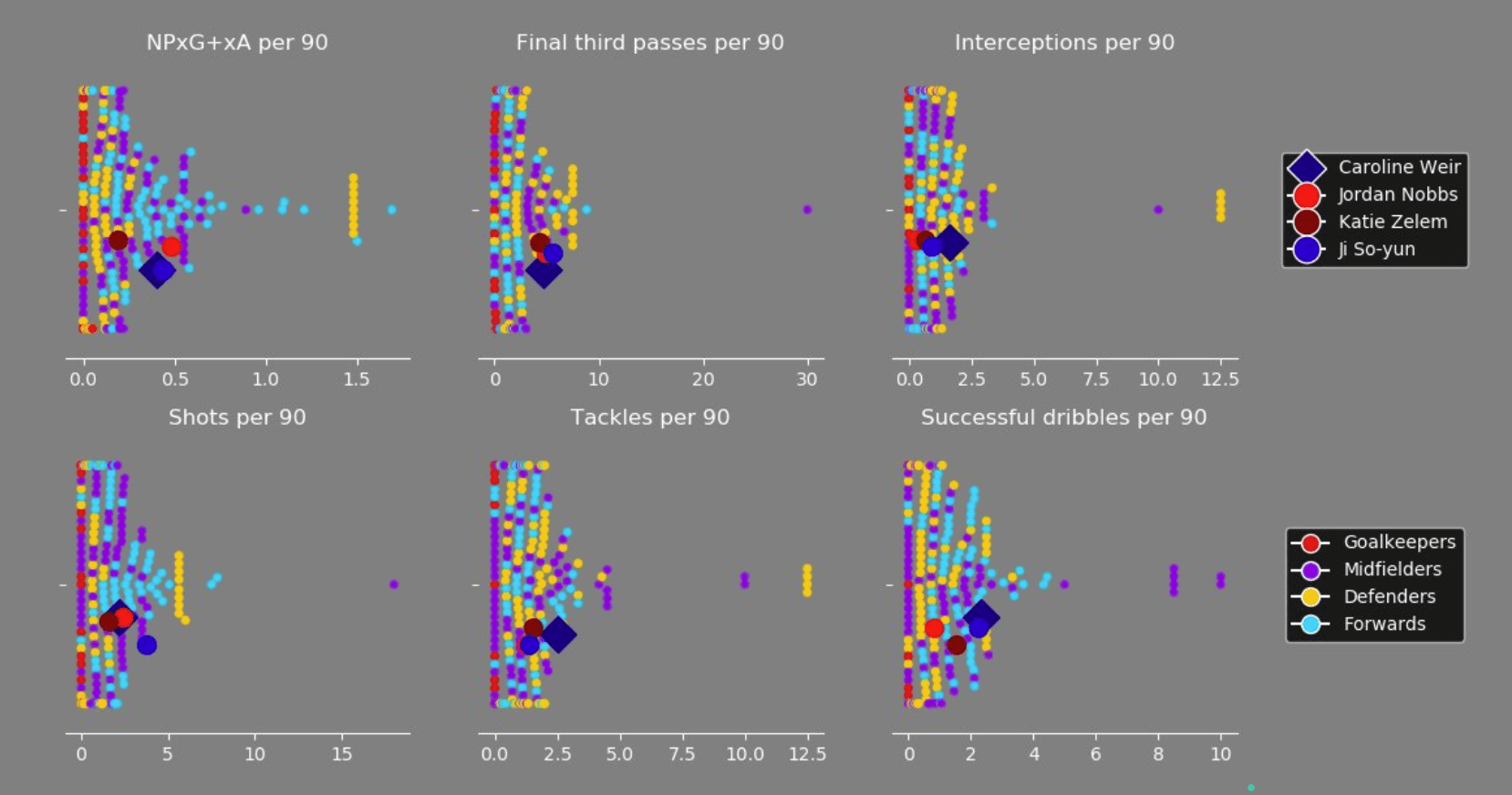
But, how does Weir fare against the rest of the league? I’ve taken the following metrics and shown the results in relation to where Weir, Nobbs, Ji, and Zelem are against the rest. The results indicate that Weir is extremely competitive under these metrics too. What this proves is that Weir is statistically one of the best playmakers in the country when compared to the best central midfielders from City’s rivals. But, how does this statistical analysis translate onto the pitch?
Attacking contributions
Now that we’ve elaborated on City’s tactics and taken an in-depth look at the numbers supporting Weir, we will now detail her on pitch contributions split between the attacking and defensive phases of play. What makes Weir such an excellent attacking presence is her positional awareness and understanding in midfield. The Scotland international displays intelligence in midfield knowing exactly where she needs to be in order to affect play moving forwards. Being partnered with Walsh gives her the freedom to push forward and assist play in and around the penalty area where she does her best work. This comes in two forms: through her passing and dribbling ability. We can see her use one-touch passing along with her excellent vision to find players before they’ve made a move.
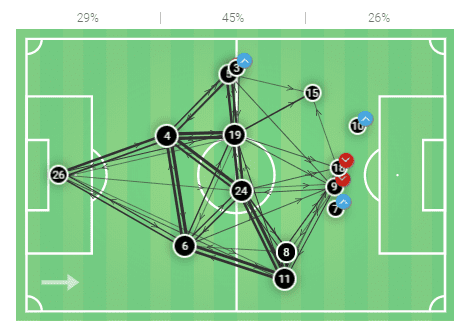
Weir averages 3.33 passes into the box and 1.67 through balls per 90. Combined with the pass map above, we can see how she starts off in a deeper position but makes late runs onto the edge of the box. Her original starting position next to Walsh gives her a chance to scan the field and assess the situation. Her position in midfield as a link player, just being part of one-two passes helps City to progress play quicker and smoother. Even under pressure, she’s able to release balls to her teammates.
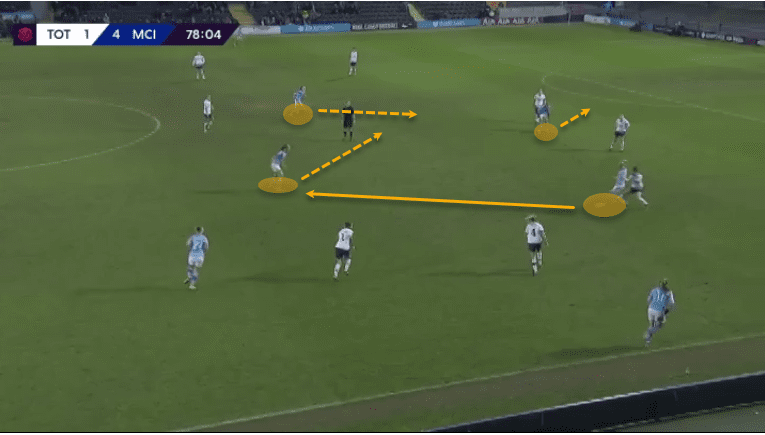
You can see an example of Weir’ intelligent positioning and passing in the graphic above. As City are building a move out on the right flank, Weir starts to assess whether or not Scott will play a long-ranged pass into Beckie who seems to be free on the right side or into her on Scott’s left. The England international decides to play a first time pass into Weir. Weir took an educated guess and moved away from her marker just before Scott received possession of the ball. This gave herself more time and space to receive the pass and suck in the central defender giving her striker space to run into.
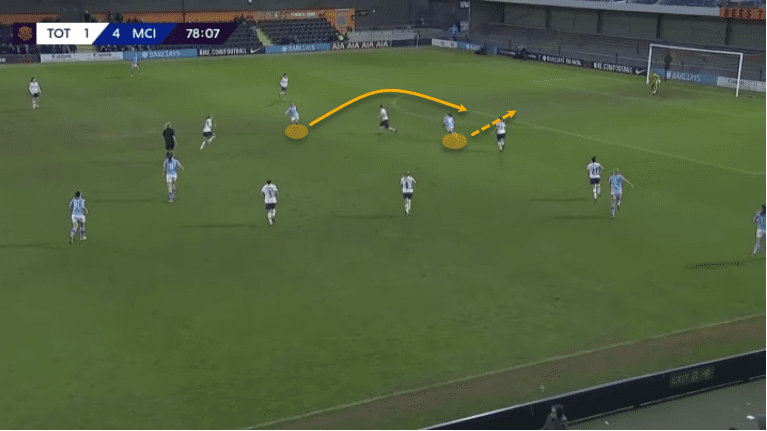
This sort of creativity and vision allows City to take more chances in the final third. The forwards take more risks when making runs or movement in the wide areas because they know Weir has the ability to find that killer pass.
As we touched upon earlier, Weir’s dribbling ability is one that has proven to be quite an asset for Manchester City. Whilst it may not be her best attribute, moving the ball forward in short spaces is something that creates space for City’s forwards. Coupled with her intelligent movement and passing, Weir’s ball progression into the final third forces the opposition to make a decision as to whether they step up to pressure her or mark her passing options. Statistically, we’ve seen that Weir averages 2.49 dribbles per 90, showing that she doesn’t exactly do this regularly.
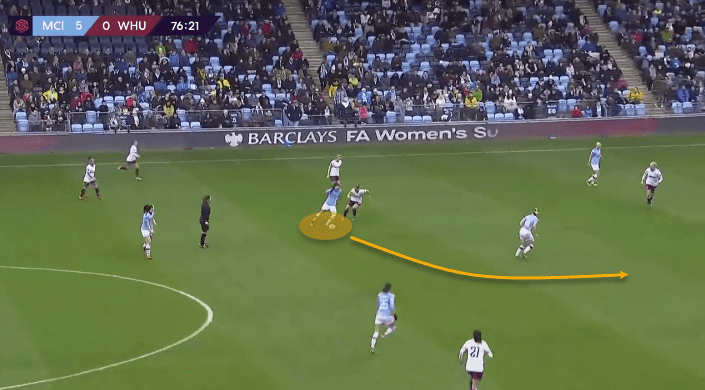
Weir’s ability to pick up possession in midfield and drive into the final third catches teams off guard. In this example, Weir won back possession in between the lines and skips past the Tottenham Hotspur midfielder to drive into the unoccupied space. That drive forward opens forces the opponent to make a decision.
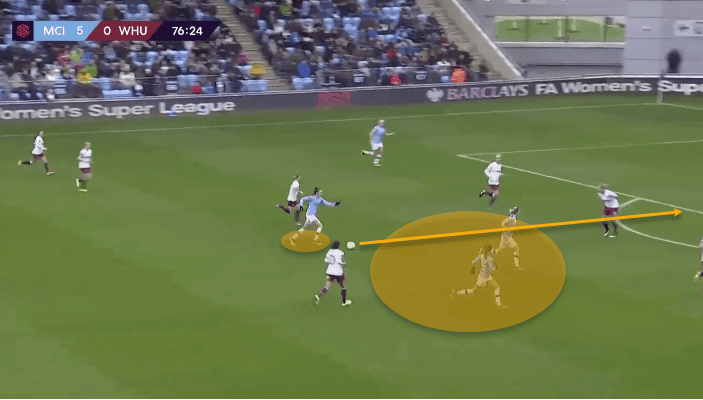
The central defender has to choose between vacating her space and pressing Weir along with the onrushing central midfielder or hold her position and allow Weir to come in. The lack of pressure on Weir gives her an opportunity to take a shot on goal and considering her ability to take long shots, it’s quite a dangerous gamble to take.
Goals have been something of a rare commodity from Weir. Since the start of the 2017/18 season, Weir has contributed six goals and eight assists. This season she currently has three goals and four assists to her name but each of these contributions have come in key games. A winning strike against Manchester United and the opener against Chelsea were both critical at the time of scoring. It’s important to address that even though she’s classified as a playmaker, the Scottish midfielder has an incredible shot taking ability from distance.
This is where she scores her goals and could score more if she was a bit more clinical. She has taken 36 shots this season yielding three goals, however, Ji has taken fewer shots (29) but has five goals to her name. This is where she could possibly improve and become an all-round world-class midfielder. Weir already gets into good positions but needs to pick and choose her moments when it comes to shooting. Doing so will give City another weapon in their arsenal to break down stubborn opposition defences.
Defensive contributions
Not only is Weir excellent in an attacking capacity but she has also proven herself to be a competent defensive player. From the statistical discussion we had earlier, it’s easy to see that the numbers have backed this notion but how does that show on the pitch?
The Scottish international’s defensive game is based around her defensive duels and interceptions through smart positioning and anticipation. Weir is able to intercept passes in midfield because of her starting position. Being strong in the tackle, Weir isn’t afraid to put in a challenge when going into a duel. Her deployment on the left side of midfield means she is able to provide an option to switch play with Beckie marauding down the right flank.
Because of her playing position, she is able to read the game and understand where teams will look to attack before they happen. The presence of Walsh next to her allows her to take more risks by stepping up and stopping attacks before they reach City’s half. Teams will be more focused on stopping the right side because of the way City operates. This gives Weir an opportunity to balance between defence and attack. As we touched upon earlier, 62.9% of her 10.09 recoveries per 90 comes in the opposition half which means she prefers to stop attacks further up the pitch. However, she is able to recover possession without giving away too many fouls.
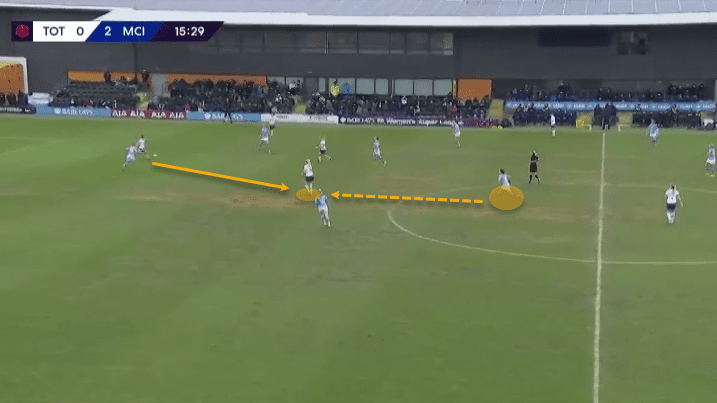
This example perfectly sums up Weir’s offensive defending. Spurs were overrun by City’s forwards for much of the first 20-25 minutes and this was down to their intense pressing. When the central defenders were in possession, they tried playing out from the back but even if they bypassed the forwards’ press, Weir would step up to try and intercept the first pass into midfield. As we can see here, Weir anticipates the pass and starts making her run towards the player. If she wins this tackle, Weir potentially puts City in a 3v2 position without much pressure from Spurs’ midfielders. City are frightening on the counter-attack and given the quality Ellen White and Pauline Bremer possess, it makes for a scary thought.
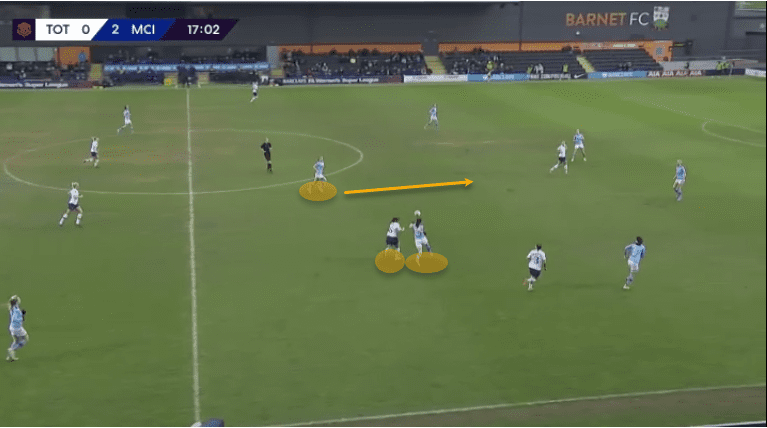
She is equally adept at defending in her own half as we can see here. While the game against Spurs saw little being offered in terms of attacking opportunities by the opposition, the odd foray forward meant Spurs double-pivot of Weir and Walsh needed to be alert. A long ball from Rebecca Spencer into midfield saw Weir challenge for the ball in Spurs’ half. The Spurs midfielder was able to bring possession into City’s half but before she could do anything meaningful, we can see Weir tussling for possession and put in a tackle. The opportunity was thwarted and gave City a chance to regroup and set up defensively again.
Some of the best defensive midfielders in the world’s best attribute comes from their reading of the game rather than any physical or technical attribute. The likes of Zelem, Sophie Ingle, and her own teammate Walsh may have the technical and physical attributes for the position but it’s their ability to understand the situation that is key. Being in the right position at the right time can be the difference between conceding a goal or launching a counter-attack. Weir has been able to intercept many passes and stray balls in midfield and stabilise the situation by playing a simple pass or launching a quick pass further forward.
Arguably one of the biggest changes in the tactics for Weir was moving away from being in a three-man midfield into a double-pivot. The partnership she’s developed with the England international has been an integral part of the way City have played. The understanding the two have made between each other has allowed City to become much more fluid in the forward areas. Beckie is able to drive down the right flank knowing she has the security and cover of Walsh whilst Weir can come across to fill in the gap Walsh leaves. Mirroring the opposite side Weir is able to provide cover and support to Megan Campbell or Stokes if they venture forward from left-back.
Being able to screen the area in front of the centre-backs is crucial especially against teams that counter-attack. The ability to shuffle across and cover both sides of the pitch becomes much easier with a double-pivot rather than a single defensive midfielder. What this duo also provides is the ability to adjust shape when they come up against more compact sides. Because of Weir’s attacking ability, City can push the midfielder into a more advanced position closer to Scott and allow Walsh to act as the sole defensive midfielder.
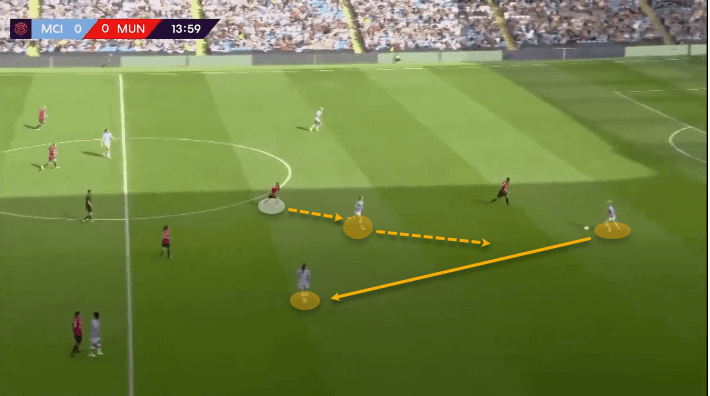
Even early in the season, we could see the cohesion between the players. Manchester United were pressing City in their own half and finding a way out was becoming tough. When Steph Houghton receives possession, Walsh realises that the return pass to Weir is the only option available. By dropping in closer to Houghton, Walsh drags the United midfielder out of position opening up space for Weir to pass out to the wide area and relieve the pressure off the defence.
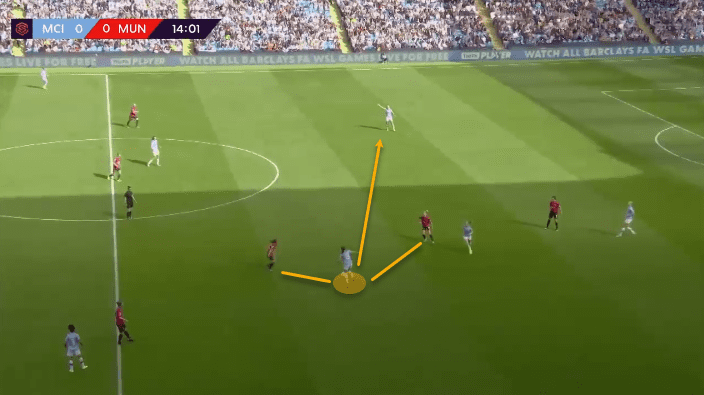
Heart of the midfield
Manchester City Women’s midfield is one of the best in the league if not Europe. The trio of Walsh, Weir, and Scott possesses a mix of experience, pace, intelligence and speed. From this analysis, we can gather that Weir is a dynamic, multi-purpose central midfielder with the ability to play both sides of the game at a high level. Her defensive ability seems slightly better than her offensive game but what is most impressive is her capability to switch gears in an instant. With City finishing the season without Cushing, the new manager will need to rely on players like Weir to ensure the title challenge continues while they try to mould and identify their new style of play. However, one thing is for certain, Weir is Manchester City Women’s dynamic playmaker and a player that is the heartbeat of their midfield.






Comments